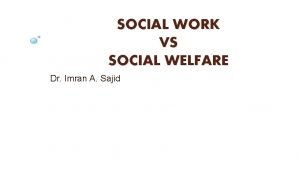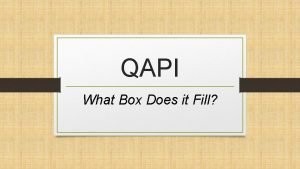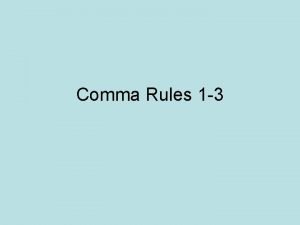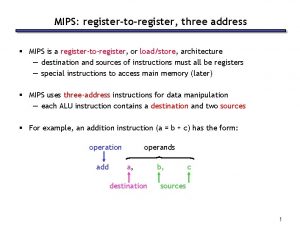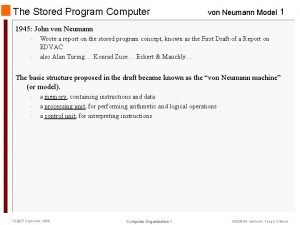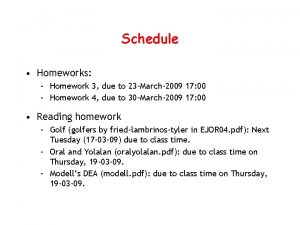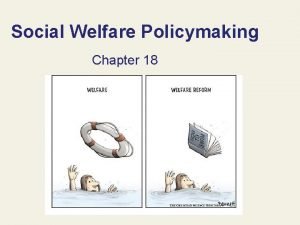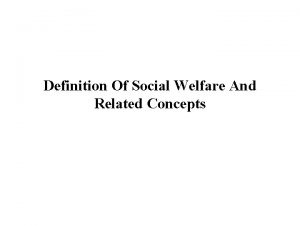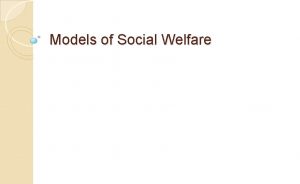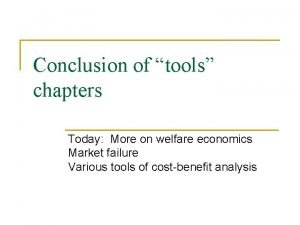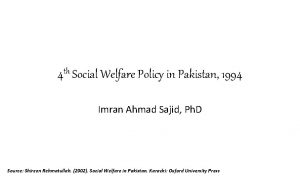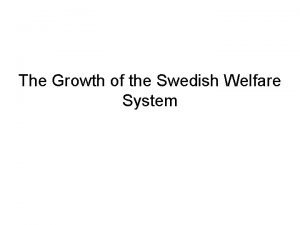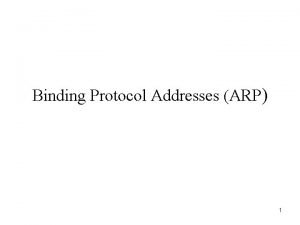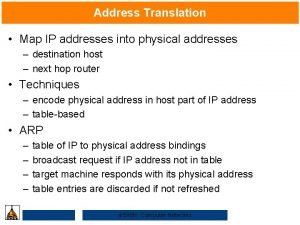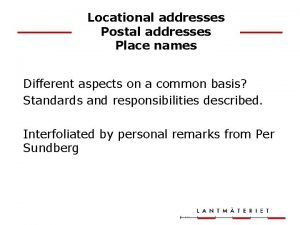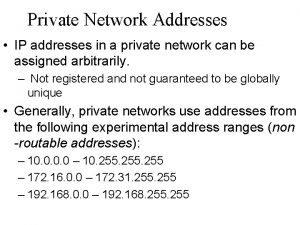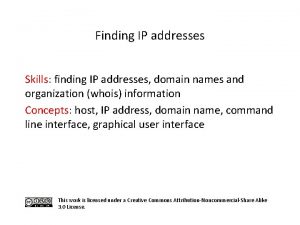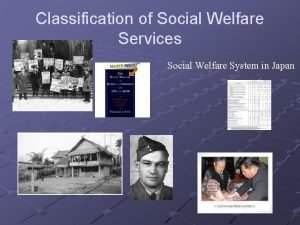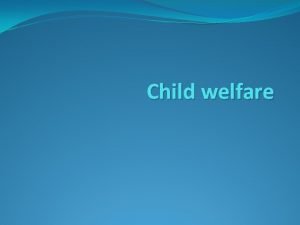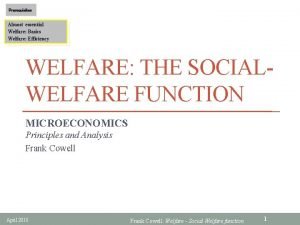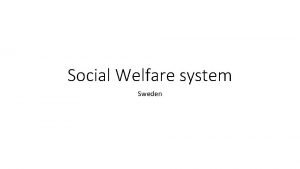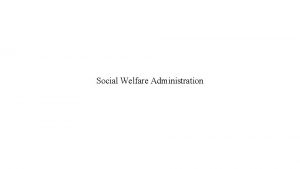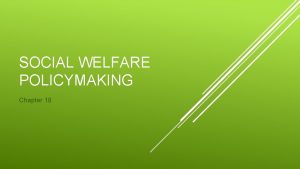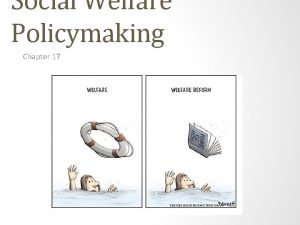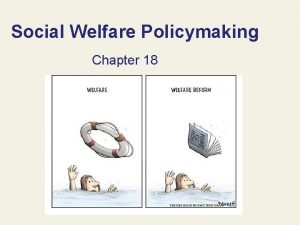The Social Welfare System Social Welfare addresses the





























- Slides: 29

The Social Welfare System • Social Welfare addresses the well-being of people in society • Social Welfare Services are created through public laws and policies, which are developed in response to large scale social needs

Two Approaches to Social Welfare • Institutional: – In place to prevent problems – Proactive – Available to all, regardless of need – Examples: Social Security and Public Education

Two Approaches to Social Welfare • Residual: – Designed to address already identified problems – Reactive – Only available to those in need – Examples: TANF and Food Stamps

History of American Social Welfare Begins in England

England • Early aid to needy was assumed by the Church – Aid to travelers – Numerous monastery/hospitals • Alms given to church meant salvation – Means for church to raise funds to care for needy • Begging became a very widespread activity – Beggars everywhere – Interfering with social activity – Beggars become somewhat insistent • Big problems between church and state

Elizabethan Poor Law of 1601 • Codified all previous legislation related to the poor • Historically previous legislation was sporadic and fragmented – Stop-gap measures without overall plan

Elizabethan Poor Law Provisions • Family Responsibility – Government last—family first • Categories of the poor – – Able bodied poor Impotent poor Mothers and children Severe penalties for giving alms to beggars • Residency requirements – Local parish responsibility – Warn away—return to parish

Elizabethan Poor Law Provisions Cont’ • Overseers of the Poor – Established eligibility • Workhouses, almshouses, etc – Indoor relief – No outdoor relief

Elizabethan Poor Law Transported to the Colonies

Social Values Influence Social Welfare Policy

Eight Periods Characterized by: • Specific Values • Social Welfare Policies

Colonial Period 1690 -1800 • • Social Policies: Elizabethan Poor Law Rules –almshouses, workhouses, etc Values: Individualism, individual responsibility for condition Individual effort highly regarded Abundant, limitless natural resources

Colonial Period • • Values: consistent with WASP traditions Morality Work ethic Carnal nature of humankind

Pre-Civil War 1801 -1860 • Social Policy: Residential Institutions • Values: placing people with similar problems together • Ease of managing needy in institutions

Civil War/Postwar Period 1861 -1874 • Social Policy: First Federal Intervention • Values: segregation, federal govt. as resources for those in need. • South in shambles—huge problems • Poor and freed slaves

Progressive Era 1875 -1925 • Social Policy: Birth of Social Work profession— social needs of immigrants/poor etc. , focus of concern • Values: – – Importance of environment and structural factors. Govt. help in correcting economic imbalances. Worker rights. Social Responsibility

Progressive Era 1875 -1925 • • • Considerable prosperity industrial production/overproduction Credit buying Spending rather than saving Needs for durable goods satisfied

Great Depression/New Deal 1926 -1940 • Social Policy: Social Insurance and Public Assistance • Values: social and economic conditions contribute to economic distress • Economy collapses

Great Depression/New Deal 1926 -1940 • • • FDR: “only thing to fear is fear itself” Federal govt. should help financially Infuse money back into the economy Put people back to work Public works projects WPA, CCC, many others

WWII and After 1941 -1959 • Social Policy: GI Bill • Values: Individual well-being • WWII may have helped end depression – Industrial production revitalized – Women working in industry/war effort

WWII and After 1941 -1959 • Home/family life—particularly nuclear families • Service personnel honored and supported

Social Reform Period 1960 -1975 • Social Policy: War on Poverty, civil rights, voting rights • Values: social responsibility, question authority • Strong effort to end poverty • Numerous social welfare programs • Johnson administration

Retrenchment Period 1976 -2000 • Regan Administration • Social programs terminated • External aid only for “worthy” poor

Retrenchment Period 1976 -2000 • Social Policy: Cutbacks and local control • Values: Individual and Family responsibility • More decision making given to states • Reduced Federal programs and controls

Social Welfare in the New Millennium 2000 -present • Social Policy: Terrorism, War, Financial Struggles • Values? ?

Predominant American Values • • • Individualism Competition Progress Materialism Capitalism/Free market

Three Types of Packaging/ Delivering Assistance • Cash assistance • In-kind benefits • Entitlements

Public Assistance Programs • • Designed to alleviate poverty “means-tested” must be poor to qualify Usually carries stigma Examples: TANF, Medicaid, food stamps, public housing

Values and Social Welfare • Change the Person or the System? • Worthy or Unworthy? • Religious Values or Separation of Church and State? • Impartial Professional or Advocate? • Helping people we know or helping strangers? • Crisis or ongoing need?
 Social welfare vs social work
Social welfare vs social work Are we running out of ip addresses
Are we running out of ip addresses Weak corrective action qapi
Weak corrective action qapi Parts of a letter
Parts of a letter The address register for storing the 8-bit addresses can be
The address register for storing the 8-bit addresses can be Classful ip addressing
Classful ip addressing As well as commas
As well as commas Reserved ip addresses
Reserved ip addresses 128 bit addresses
128 bit addresses Ap style miles per hour
Ap style miles per hour Utkarsh jaiswal
Utkarsh jaiswal Mips register addresses
Mips register addresses Three address statement
Three address statement Modello von neumann
Modello von neumann (acv-s03) homework - addresses and references
(acv-s03) homework - addresses and references Welfare programs in the us
Welfare programs in the us Industrial achievement model of social welfare
Industrial achievement model of social welfare Remedial model of social group work
Remedial model of social group work Social welfare services definition
Social welfare services definition Models of social welfare
Models of social welfare Conclusion of welfare economics
Conclusion of welfare economics 2nd social welfare policy in pakistan
2nd social welfare policy in pakistan Tools of normative analysis
Tools of normative analysis Social welfare in colombia
Social welfare in colombia Ethics and social welfare
Ethics and social welfare Premipension
Premipension Welfare management system
Welfare management system R a 9344
R a 9344 Social thinking adalah
Social thinking adalah Social thinking social influence social relations
Social thinking social influence social relations
